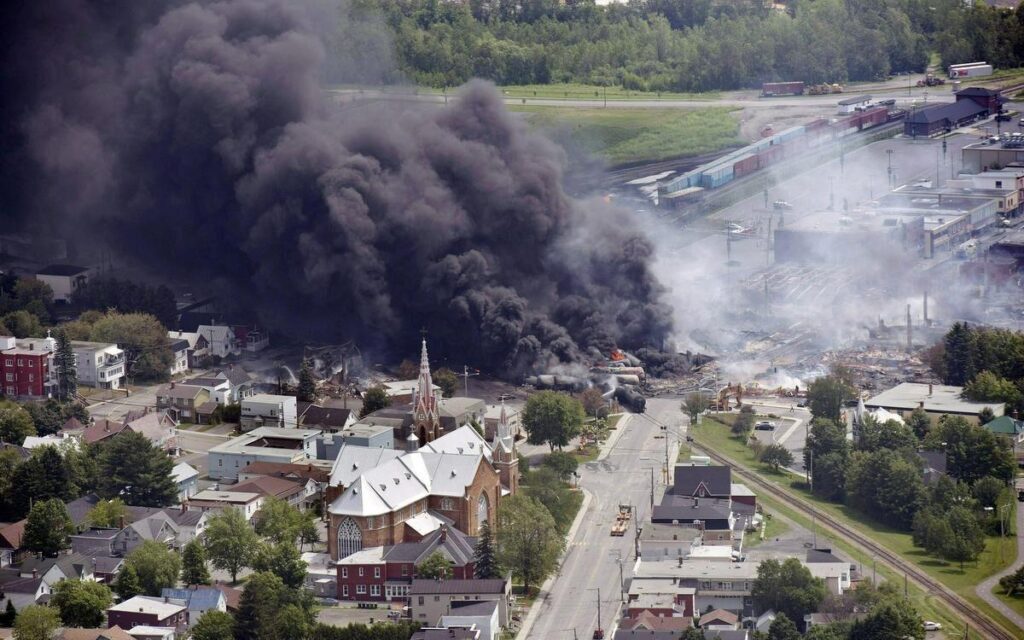Day of Accident:
In October 2012, the lead locomotive, a GE C30-7 designated #5017, was sent to MMA’s repair shop following an engine failure. Because of the time and cost for a standard repair and the pressure to return the locomotive to service, the engine was repaired with an epoxy-like material that lacked the required strength and durability. #5017 was then put on freight train “MMA 2” which departed the CPR yard in Côte-Saint-Luc early in the day of July 5 and changed crews at the MMA yard in Farnham, Quebec. After departing Farnham, it stopped at about 23:00 at the designated MMA crew change point in Nantes, which is 11 kilometers (6.8 mi) west of Lac-Mégantic.

The engineer, Tom Harding, parked the train on the main line by setting the brakes and followed standard procedure by shutting down four of the five locomotives. Harding could not park the train on the adjacent siding because MMA used it routinely to store empty boxcars for Tafisa, a particleboard factory in Lac-Mégantic’s industrial park. The Nantes siding has a derail that could have stopped the train from accidentally departing. According to Transport Canada, it is unusual to leave an unattended train parked on a main line, but there were no regulations against it. Harding left the lead locomotive No. 5017 running to keep air pressure supplied to the train’s air brakes and also applied a number of hand brakes. Yves Bourdon, a member of MMA’s board of directors, stated that the air brakes of all locomotives and freight cars had been activated, as well as hand brakes on 5 locomotives and 10 of the 72 freight cars. However, the TSB agrees with a July 6 statement to police by Harding that he set hand brakes on just the five locomotive engines, a buffer car, and a car housing the remote-control apparatus. Harding also attempted a brake test but incorrectly left the locomotive air brakes on; this gave the false impression that the hand brakes alone would hold the train. Harding contacted the rail traffic controller in Farnham to advise them that the train was secure. Next, he contacted the rail traffic controller in Bangor, Maine, to report that the lead locomotive had experienced mechanical difficulties throughout the trip and that excessive black and white smoke was coming from its smokestack. Expecting the smoke to settle, they agreed to deal with the situation the following morning. Section 112 of the Canadian Rail Operating Rules states, “when equipment is left at any point a sufficient number of hand brakes must be applied to prevent it from moving” and “the effectiveness of the hand brakes must be tested” before relying on their retarding force. The engineer tests the hand brakes by seeing if the train budges when trying to push and pull the train with locomotive power. If a train is left on an incline, the number of handbrakes needed to hold the train increases. It takes 2–3 minutes per car to set the hand brakes. The track from Nantes to Lac-Mégantic is downhill on a 1.2% grade. Nantes is 515 meters (1,690 ft) above sea level, Lac Mégantic is 108 m (354 ft) lower at 407 m (1,335 ft).

The MMA claimed that its braking policy required the activation of hand brakes on the five locomotives and 11 freight cars, or 20.5% of the total train. However, the TSB confirmed evidence in the criminal charges citing MMA procedures requiring nine brakes to hold a 70–79 car train. The TSB concluded that a minimum of 17 and possibly as many as 26 hand brakes would have been needed to secure the train, depending on the amount of force with which they had been applied. Transport Canada does not validate the special instructions of a railway company or give any specific guidance on how many brakes must be applied for parked freight trains. While Transport Canada had repeatedly reprimanded MMA from 2004 to 2009 and in 2011 and 2012 for violations of CROR Section 112 handbrake requirements on parked trains in Nantes, no fines had been issued for the infractions. The TSB found that MMA’s operating plan was to leave the train parked on the main line, unattended, with an unlocked locomotive cab, alongside a public highway where it was accessible to the general public, with no additional protection. However, there were no rules against leaving a train unlocked, running and unattended, even if it contained dangerous materials and was stopped on the main line, on a slope, in the vicinity of a residential area. After finishing his work, Harding departed by taxi for a local hotel, l’Eau Berge in downtown Lac-Mégantic, for the night. En route, the engineer told the taxi driver that he felt unsafe leaving a locomotive running while it was spitting oil and thick, black smoke. He said he wanted to call the U.S. office of MMA (in Hermon, Maine) as they would be able to give him other directives. Taxi driver André Turcotte described the engineer as covered in droplets of oil, which also covered the taxi’s windscreen.
Witnesses recalled seeing the train seemingly unattended and in distress around 22:45 that night. People driving on the road that parallels the rail line near Nantes recall seeing the train and having to slow down as they passed the locomotives where there was a thick dark blue cloud of diesel smoke being emitted as well as sparks coming out of a locomotive’s exhaust, due to a broken piston in its diesel engine. According to the TSB, the MMA’s rail traffic controller was warned of the train having technical difficulties while the train was still in Nantes on the evening of Friday, July 5. After the engineer had departed, the Nantes Fire Department as well as a police officer from the Sûreté du Québec’s Lac-Mégantic detachment responded to a 911 call from a citizen at 23:50 who reported a fire on the first locomotive; according to Nantes Fire Chief Patrick Lambert, “We shut down the engine before fighting the fire. Our protocol calls for us to shut down an engine because it is the only way to stop the fuel from circulating into the fire.” The fire department extinguished the blaze and notified the Montreal, Maine and Atlantic Railway’s rail traffic controller in Farnham. MMA did not grant permission to the engineer to return to the scene, instead summoning a track maintenance foreman unfamiliar with the operation of railway air brakes.

By 00:13 two MMA track maintenance employees had arrived from Lac-Mégantic; the Nantes firefighters left the scene as the MMA employees confirmed to the police officer and to the Farnham rail traffic controller that the train was safe. The MMA has alleged that the lead locomotive was tampered with after Harding had left; that the diesel engine was shut down, thereby disabling the compressor powering the air brakes, which allowed the train to roll downhill from Nantes into Lac-Mégantic once the air pressure dropped in the reservoirs on the cars. Teamsters Canada Rail Conference vice-president Doug Finnson disputed this theory, stating that the key braking system on a stopped, unsupervised train are the hand brakes, which are completely independent from the motor-powered compressor that feeds the air brakes.
With all the locomotives shut down, the air compressor no longer supplied air to the air brake system. As air leaked from the brake system, the main air reservoirs were slowly depleted, gradually reducing the effectiveness of the locomotive air brakes. At 00:56, the air pressure had dropped to a point at which the combination of locomotive air brakes and hand brakes could no longer hold the train, and it began to roll downhill toward Lac-Mégantic, just over 11 kilometers (7 mi) away. A witness recalled watching the train moving slowly toward Lac-Mégantic without the locomotive lights on. The track was not equipped with track circuits to alert the rail traffic controller to the presence of a runaway train. About ten minutes before the derailment occurred, firefighter Jean-Luc Montminy, who was heading home after helping put out the fire on the original locomotive of the train, was stopped at a railway crossing on Quebec Route 161, located just south-east of where the train began to roll. He stated that the crossing had activated and was warning of an oncoming train, but after waiting for some time, he heard no horn or any signal that a train was approaching. Thinking that the crossing was malfunctioning, he proceeded over the intersection when just as he had finished crossing, a train without its headlights or horn passed through at a very fast speed. Montminy recognized that it was the same train he had responded to hours earlier, and quickly returned to Nantes to inform other firefighters about what he had just witnessed. Gathering momentum on the long downhill slope, the train entered the town of Lac-Mégantic at high speed. The TSB’s final report concluded that the train was travelling at 105 kilometers per hour (65 mph), more than six times the typical speed for that location. The rail line in this area is on a curve and has a speed limit for trains of 16 kilometers per hour (10 mph) as it is located at the west end of the Mégantic rail yard.
